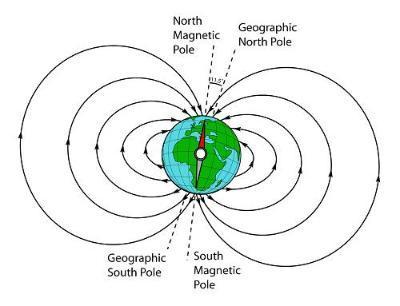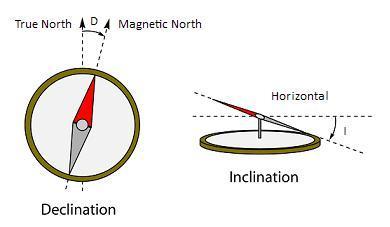The Earth's magnetic field
Archaeomagnetic dating is based on two principles:
- The Earth has a magnetic field that changes with time
- Specific events can cause materials to record information about the Earth's magnetic field
The Earth's magnetic field can be represented by field lines focused on two poles (i.e. a dipolar field). It is important to note that the magnetic poles are not the same as the Geographic poles.

(Image redrawn from Aitken (1990) by D. Bashford).
The magnetic field can be described using three measurable parameters:
| Parameter | Definition |
|---|---|
| Declination | The angle between magnetic north and geographic north |
| Inclination | The dip of the field direction above or below the horizontal |
| Intensity | The magnitude or strength of the magnetic field (strength of the force of attraction or repulsion experienced) |

(Image redrawn from Prof. Ben Datillo's site http://faculty.weber.edu/bdattilo/shknbk/notes/pleomg.htm (last accessed 8/4/2010) by D. Bashford).
The declination and inclination values define the direction of the Earth's magnetic field. Specific events can cause the magnetic materials to record information about the direction and strength of the magnetic field. If we know how the magnetic field has changed over time, and we can measure the information held within the magnetic minerals about the past magnetic field, we can produce a date.
We therefore need a record of how the position and strength of the Earth's magnetic field has changed over time. We cannot predict how it will change as it does not follow a simple law or pattern. We have to rely on:
- Recent observations: it was first realised that the direction of the Earth's field changes with time in the 16th century, since which time scientists (beginning with Henry Gellibrand) have periodically made observations of the changes in both the declination and inclination at magnetic observatories
- Direct measurements of archaeological materials: the age of the deposit needs to be found using alternative methods, such as radiocarbon dating, documentary sources or the archaeological evidence
The record of how the field has changed is referred to as a secular variation curve and is used to calibrate the measured information to obtain a calendar date (Clark et al. 1988, 647). For more information, see the 'Secular variation and calibration' section.
